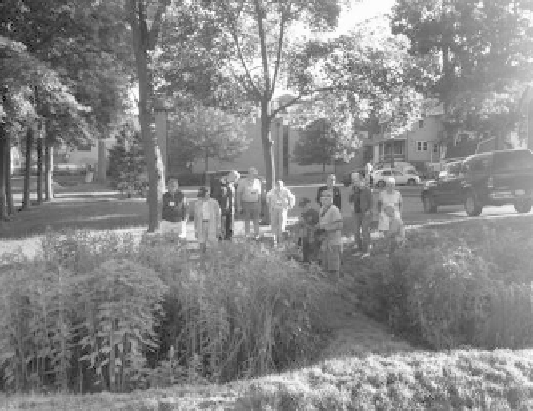Environmental Engineering Reference
In-Depth Information
research, still ongoing, is measuring the functionality, durability, and cost-effectiveness of
different Osorbs with reactive metal components at each study site.
Site 1 (Figure 33.1), built in July 2011, is a twin-chamber system. Chamber 1 contains Fe-
Osorb ill media. The second is a control chamber that does not contain Osorb. The unit
is located at the College of Wooster in Wooster, Ohio, and drains 3.5 acres, including 80
parking spaces, a dumpster parking pad, and four buildings.
Site 2 (Figure 33.2), built in July 2012, drains ~6.5 acres of industrial site runoff, including
220 parking spaces, six loading docks, and 120,000 ft
2
of industrial rooftops. The site has
been an active industrial site for >50 years with legacy chemical residues, including fuels,
halons, solvents, and various chemicals associated with the site's 30-year use as a photog-
raphy and microiche processing facility.
Site 3, now in the engineering and permit phase, will drain 8.2 acres of parking road-
ways and rooftops at an active hospital complex.
During the irst 16 months of testing at site 1 and 5 months at site 2, testing has validated
substantial advantages to using nanoglass Osorbs in the runoff systems, and in most cases
the ield results are exceeding the results predicted from column tests conducted in a labo-
ratory setting. The possible reasons for results are examined in the science review below;
however, in summary:
1. Osorb added to stormwater systems removes at least 90%, and often 99.9%, of
industrial and urban pollutants in the runoff. The concentration of volatile organic
contaminants in runoff at times exceeds 400 ppm, and the Osorb nanoglass con-
sistently reduces the concentration to <1 ppm.
2. Osorb in the stormwater system removes volatile organics directly but has the
“knock-on” effect of creating extremely robust and healthy rhizome and soil
FIGURE 33.1
Tour group observes the nanoglass Osorb stormwater system at the College of Wooster. This is Study Site 1 for
an NSF study of Osorb nanoglass-enabled stormwater treatment. Note: An extremely robust plant has been
observed, here shown at only 12 months after initial planting. All plants are far larger and more robust than
either a control bed or what would normally be expected for plants being fed waters directly from an urban
parking lot and dumpster storage area.

